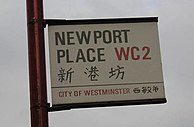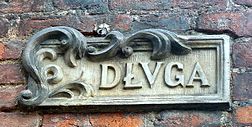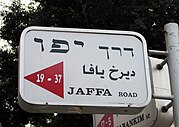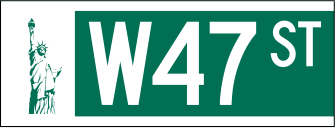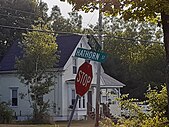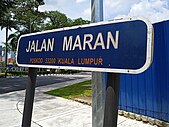Street name sign
This article has multiple issues. Please help improve it or discuss these issues on the talk page. (Learn how and when to remove these template messages)
|

A street name sign is a type of
Description




Modern street nameplates (name signs) may be mounted in various ways, such as attached to walls or on
Some street nameplates also indicate the range of
Occasionally some signs are a target for vandalism, for example in areas of language controversy; and signs on unusually or famously named streets (perhaps those containing a humorous or obscene word) are especially liable to street sign theft.
In recent years, many US and Canadian cities have adopted the
Color coding and typography

Usually, the color scheme used on the sign just reflects the local standard (for example, white letters on a green background are common throughout the US). However, in some cases, the color of a sign can provide information, as well. One example can be found in
As of 2009[update], the
In 1952 in the UK,
Gallery
- Street name signs
-
Historic marble street sign in Rome, Italy
-
Palermo, Italy
-
Madrid, Spain
-
Spanish street sign, Calle Laurel
-
Street sign, Linz, Austria
-
Street sign Salzburg, Austria
-
Street sign, Vienna, Austria
-
Sign in Zürich, Switzerland
-
Marx-Engels-Platz(1984)
-
Bilingual (Niçois) wall-mounted street signs in Nice, France
-
A street sign in Montmartre, Paris
-
A bilingual street sign inUlster Scots and English in Ballyhalbert, Northern Ireland
-
Street sign at Długa Street in Gdańsk, Poland
-
Street name sign in Prague, Czech Republic
-
Historic Hungarian/German street sign in Bratislava, Slovakia
-
Haifa, Israel
-
A street sign in Tel Aviv, Israel
-
Via Dolorosa, Jerusalem
-
Example in Bukhara, Uzbekistan
-
A street sign in Isfahan, Iran
-
Street sign, Hong Kong
-
Street sign, Macau
-
Internally illuminated mast-mounted street sign in Whittier, California
-
Bilingual sign in Fredericksburg, Texas
-
Tiles in the sidewalk mark many streets in the older neighborhoods of New Orleans, Louisiana
-
"Midtown Manhattan" sign, New York City
-
Four and a half street in Berwick, Pennsylvania
-
Alternating numeral and spelled-out street name signs in San Jose, California
-
Street sign in São Paulo, Brazil
-
Street sign in Kuala Lumpur, Malaysia
See also
- FHWA Series fonts
- List of public signage typefaces
- Street sign theft
- Traffic sign
References
- ^ Bacho, Katia (June 24, 2013). "On the Street Clarity". The New Yorker (subscription needed). p. 30.
- ^ "Manual on Uniform Traffic Control Devices 2009 Edition Chapter 2D. Guide Signs—Conventional Roads". Federal Highway Administration. Retrieved March 4, 2015.
- ^ Richard Kindersley Studio official website
External links
- Language of the Street - an analysis of street signs in Newcastle-upon-Tyne, Colchester, Londonand other UK cities.
- Street signs from "The ultimate street signs and house numbers site"
- Old street signs in Oxford (UK)












